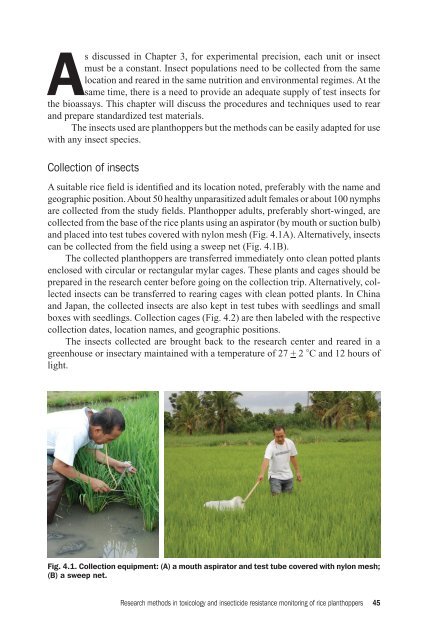Research Methods in Toxicology and Insecticide Resistance ...
Research Methods in Toxicology and Insecticide Resistance ...
Research Methods in Toxicology and Insecticide Resistance ...
You also want an ePaper? Increase the reach of your titles
YUMPU automatically turns print PDFs into web optimized ePapers that Google loves.
As discussed <strong>in</strong> Chapter 3, for experimental precision, each unit or <strong>in</strong>sect<br />
must be a constant. Insect populations need to be collected from the same<br />
location <strong>and</strong> reared <strong>in</strong> the same nutrition <strong>and</strong> environmental regimes. At the<br />
same time, there is a need to provide an adequate supply of test <strong>in</strong>sects for<br />
the bioassays. This chapter will discuss the procedures <strong>and</strong> techniques used to rear<br />
<strong>and</strong> prepare st<strong>and</strong>ardized test materials.<br />
The <strong>in</strong>sects used are planthoppers but the methods can be easily adapted for use<br />
with any <strong>in</strong>sect species.<br />
Collection of <strong>in</strong>sects<br />
A suitable rice fi eld is identifi ed <strong>and</strong> its location noted, preferably with the name <strong>and</strong><br />
geographic position. About 50 healthy unparasitized adult females or about 100 nymphs<br />
are collected from the study fi elds. Planthopper adults, preferably short-w<strong>in</strong>ged, are<br />
collected from the base of the rice plants us<strong>in</strong>g an aspirator (by mouth or suction bulb)<br />
<strong>and</strong> placed <strong>in</strong>to test tubes covered with nylon mesh (Fig. 4.1A). Alternatively, <strong>in</strong>sects<br />
can be collected from the fi eld us<strong>in</strong>g a sweep net (Fig. 4.1B).<br />
The collected planthoppers are transferred immediately onto clean potted plants<br />
enclosed with circular or rectangular mylar cages. These plants <strong>and</strong> cages should be<br />
prepared <strong>in</strong> the research center before go<strong>in</strong>g on the collection trip. Alternatively, collected<br />
<strong>in</strong>sects can be transferred to rear<strong>in</strong>g cages with clean potted plants. In Ch<strong>in</strong>a<br />
<strong>and</strong> Japan, the collected <strong>in</strong>sects are also kept <strong>in</strong> test tubes with seedl<strong>in</strong>gs <strong>and</strong> small<br />
boxes with seedl<strong>in</strong>gs. Collection cages (Fig. 4.2) are then labeled with the respective<br />
collection dates, location names, <strong>and</strong> geographic positions.<br />
The <strong>in</strong>sects collected are brought back to the research center <strong>and</strong> reared <strong>in</strong> a<br />
greenhouse or <strong>in</strong>sectary ma<strong>in</strong>ta<strong>in</strong>ed with a temperature of 27 + 2 °C <strong>and</strong> 12 hours of<br />
light.<br />
A B<br />
Fig. 4.1. Collection equipment: (A) a mouth aspirator <strong>and</strong> test tube covered with nylon mesh;<br />
(B) a sweep net.<br />
<strong>Research</strong> methods <strong>in</strong> toxicology <strong>and</strong> <strong>in</strong>secticide resistance monitor<strong>in</strong>g of rice planthoppers 45

















